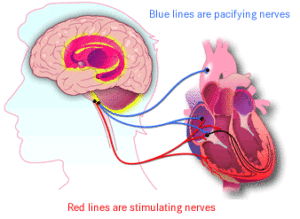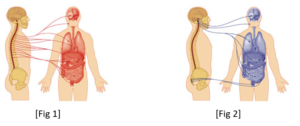The Cumulative Effects of an Unbalanced System
Unfortunately, our nervous systems have not yet adapted to the type of ongoing stress we face today. As you can imagine, there is a huge difference between the constant stress of 21st century life and our ancestor’s sudden need to flee from danger. However, ongoing minor stresses such as traffic jams, work demands, problems at home, or financial concerns tend to build up. Emotions such as anger, fear and anxiety will cause your Sympathetic Nervous System (SNS) to activate. As stress accumulates, your stress response remains active for longer than your body can handle. Your relaxation response, therefore, is less active, which throws your Autonomic Nervous System (ANS) out of balance.
 Over time, repeated stressors and negative emotions have a cumulative wear and tear on the body that can lead to significant health problems. This is called “allostatic load”. When you are healthy, your nervous system returns to normal functioning after a stressed situation by increasing vagus nerve activity. This helps the system to recover. When you are faced with stress on a daily basis, however, your stress response fails to shut off in a timely manner.
Over time, repeated stressors and negative emotions have a cumulative wear and tear on the body that can lead to significant health problems. This is called “allostatic load”. When you are healthy, your nervous system returns to normal functioning after a stressed situation by increasing vagus nerve activity. This helps the system to recover. When you are faced with stress on a daily basis, however, your stress response fails to shut off in a timely manner.
Allostatic load leads to reduced activity of your vagus nerve. As a result, your system becomes hyperactive or begins to burn out.
Hyperactive stress responses cause your system to remain in fight-or-flight mode for an extended period of time. Burn-out inhibits both your SNS and Parasympathetic Nervous System (PNS) from activating. In both cases, your body becomes out of balance, making your system less flexible and less able to effectively adapt to external demands. Over time, allostatic load can cause significant health problems. There is now a large amount of literature on the relationship to stress and disease. According to the American Institute of Stress, “it is hard to think of any disease in which stress cannot play an aggravating role. “In fact, the Institute reports that up to 90% of doctors visits are stress related.”
The Balance of Your Nervous System
Your Autonomic Nervous System (ANS) controls functions in the body that normally occur unconsciously, such as heart rate, respiration rate and digestion. This system is responsible for keeping your body in a regulated, balanced state. This balance is created by the constant back and forth nature of the two primary branches of your ANS: the Sympathetic Nervous System (SNS) and the Parasympathetic Nervous System (PNS).

Your SNS is involved in mobilization responses that enable “fight or flight” behaviors known as the stress response [Fig. 1]. Your PNS is involved in “rest and renew” behaviors that enable growth and restoration and are known as the relaxation response [Fig. 2]. Parasympathetic activity is regulated by your vagus nerve. The vagus nerve is the longest nerve in your body, extending from the brain stem to the base of the spine and to several organs and your heart. When the vagus nerve activates, the relaxation response is turned on. When the vagus nerve is inactive, the relaxation response is also inactive.
Typical functions of the SNS and PNS are detailed below:
Sympathetic Nervous System (SNS)
Your “fight or flight” or stress response can become activated by both major and minor stressors. Even states of excitement and emotions such as anger and fear activate the SNS. When your SNS is active it is characterized by:
- Increased heart rate
- Increased cardiac output
- Increased blood pressure
- Increased breathing rate
- Increased muscle contraction
- Constriction of capillaries under skin surface
- Increased secretion of adrenaline (epinephrine), noradrenaline (norepinephrine), and cortisol
- Increased brainwave activity
- Increased output of blood cholesterol
- Increased blood sugar
- Increased insulin levels
- Inhibited digestion and elimination
- Weakened the immune system (long-term)
- Inhibited of cell growth (long-term)
Parasympathetic Nervous System (PNS)
The primary pacifying nerve in your body, the vagus nerve, mediates the activity of the “rest and renew” or relaxation response. Overall, activation of the PNS promotes calming so you can recuperate from day-to-day stress, keeping the ANS in balance. When your PNS is active it is characterized by:
- Decreased heart rate
- Decreased cardiac output
- Decreased blood pressure
- Decreased breathing rate
- Released tension in tight muscles
- Dilated of blood vessels
- Released dopamine, serotonin, and acetylcholine
- Enhanced cognition
- Stabilized blood flow to muscles
- Increased oxygen to the blood
- Increased energy storage
- Enhanced digestion and elimination
- Strengthened immune system (long-term)
- Promotion of cell growth (long-term)
Ideally, the SNS and PNS operate in an evenly balanced manner, keeping your body in a state of physiological homeostasis. Although there are exceptions, in general when SNS activity increases, PNS activity decreases. In particular, when SNS activity increases, the activity of the vagus nerve decreases. SNS changes in your body are all extremely important, particularly if you are in a life threatening situation in which you have to fight or escape. When the stressful moment has passed, the PNS response kicks in to relax your body and return it to a balanced state.
Back to Articles of Interest